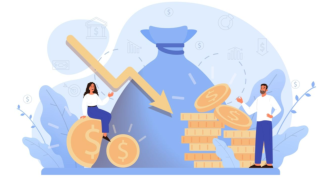
Market Downturns on Everyone's Mind
Market Now:
Consumer increase in spending is slowing down. At least it is growing at a slower rate than last month, says the credit card issuers. Remember the trend is more important than the absolute number. Reflecting recession fears, stocks have been declining this week and the yield curve inversion is steepening at the same time.
The Fed meets next week with expectations of a ½ point increase instead of the last 4 meetings increase of ¾ point. Again, the trend is for lowering the number of increases with the Fed saying the rate goal may be moving higher. Markets fear that the Fed is being too aggressive with rates increasing the likelihood of recession.
China is easing covid restrictions which should help the US economy over time. One response to events in China and the resulting disruption to the US supply chain is manufacturing, especially in semiconductors moving back to the US. Billions are being invested by Samsung, Intel and Taiwan Semiconductor in building new semiconductor plants that will create tens of thousands of new domestic jobs. When covid began, one forecast I made was that manufacture of critical goods would move back to the US despite increased domestic costs. That seems to be happening. Incentives for domestic manufacturers of semiconductors have increased incentives to increase domestic production of semiconductors.
More inflation news will be published on Friday with the Producer Price Index. Again, if the monthly increase is lower than the month before, the trend will be viewed as positive. Aside from the producer price index, prices for selected goods are beginning to fall. If the PPI number is lower than predictions this would help markets. When the Fed is done increasing rates or even more importantly when the economy slows down enough to be recessionary, that is when we are likely to see market lows.
The midterm elections are finally over with control of the House with Republicans and control of the Senate with Democrats. Split government should result in lots of smoke but basically paralysis in terms of legislation. Politics has never been a reason to make any investment strategy changes and now is no different. With the Fed continuing interest rate increases, US treasury yields remain extremely attractive.
Remember that US I-Bonds can be purchased individually (not through your accounts at SAS). https://www.treasurydirect.gov/savings-bonds/i-bonds/
Each individual can purchase up to $10,000 in I-Bonds and the prevailing rate is 6.89% (12/8). If you don't have a Treasury Direct account and you would like to purchase I-bonds, you may do so by following the steps in this link: https://www.treasurydirect.gov/RS/UN-AccountCreate.do. Questions? Let your SAS advisor team know.
Investor Strategy:
Do you own stocks, including and especially company equity like RSUs/ESPP shares, and other investments in taxable brokerage accounts such as Individual, Joint, Community Property, or Trust accounts?
Market downturns are on everyone’s mind. Economic conditions like those we have experienced so far in 2022 offer interesting looks into “losses” and “what is a loss” in terms of tax planning strategies and diversifying household investments.
First, any SAS Financial Advisors conversation and content related to “tax planning and strategies,” will be unique to your household, situation, and specific household data. As such, always review and confirm with your tax professional before acting on any of the information provided below.
Often, based on our experience advising client household portfolios bloating in certain concentrations in single company stock, including employer stock, across 1 or more companies that may continue to have future shares vesting, it’s been challenging to practice the “most conservative” strategy which is to sell RSU and ESPP company stock immediately upon vesting into cash proceeds.
The advantages to selling immediately upon vesting are realizing real cash proceeds, avoiding market risk (stock price drops below vest price). Further, this strategy incurs only income tax on the vest price, applicable in all cases either way, and minimal, if any, additional gains tax on any gains/losses. Additionally, selling company stock immediately upon vesting generates cash proceeds for further diversification in a wide swath of companies at once such as is offered in very low expense ratio index funds lowering the exposure to a single company investment risk - particularly in a company where half or more of household income and client time and benefits are spent already - a high concentration in total “life exposure” beyond investment exposure in a single company.
Have you experienced hesitation deciding when to sell single company stock concentrations? This is completely natural and normal given our human behavioral financial tendencies, it’s easier not to act, and who knows, the stock price might also go up. Interestingly enough though, holding on to company stock is the “riskiest” strategy, when at the same time, it often feels quite the opposite. While there is a component of “tax risk,” in that any gains in the long term will be taxed at more favorable long term capital gains tax rates if the stock has been held for at least 1 year plus 1 day since the vest date (note: potentially longer for ESPP) before selling, waiting any amount of time opens up “market risk,” where any gains may drop in value and negate any tax benefit and lower overall cash proceeds from any sale.
The stock vesting (which becomes the “cost basis”) at $100/share (when income taxes in the year of vest are on the vest price only), goes up to $150/share, and is sold in 1 year and 2 days at $150/share. Each share is taxed on long term capital gains on $50/share. Long Term capital gains can be short-cut calculated as: 20% for federal and 10% for state, or 30% combined. 30% of $50 is $16.67 long term capital gains tax per share.
So, if the stock only goes up to $133.33, and is sold in 300 days, the tax is only $14.85 per share at short term capital gains rates (=income tax rates, or 45% combined federal and CA state rates, short-cut calculated). This example emphasizes that waiting for more favorable long term capital gains rates ends up in very small impacts on overall capital gains taxes to be paid relative to the size of the gain.
+
If the stock ends up dropping in price to $90/share, then there is an option to sell in order to “harvest capital losses,” in this case, it is better to wait for long term capital losses by selling losses after owning the stock for one year and one day. Selling sooner is a short-term capital loss and only $3k/year of short-term total capital losses is allowable as deductible against income.
Weekly Catch-Up - News Articles That Caught Our Eye
- What happens to a woman when she becomes a mother
- https://www.cnn.com/2022/12/06/health/why-winter-colds-flu-wellness
- 4 Nutrients That Can Decrease Your Risk Of Depression, According To A UCLA Clinical Instructor (msn.com)
- The Holidays - Cheerful Or Challenging? (forbes.com)
- Which to Choose: Medicare or Medicare Advantage? - The New York Times (nytimes.com)
|
|
|
||
This website is informational only and does not constitute investment advice or a solicitation. Investments and investment strategies recommended in this blog may not be suitable for all investors. SAS Financial Advisors, LLC and its members may hold positions in the securities mentioned within this newsletter. SAS Financial Advisors, LLC is not responsible for any third-party content referenced.
The SAS Newsletters are posted on the SAS Blog weekly: https://www.sasadvisors.com/blog

